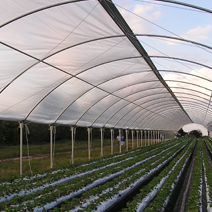Know the pros and cons before choosing your commercial greenhouse covering
Choosing a greenhouse covering is an important decision for a grower and depends on a number of factors including durability, climate, light transmission and cost-efficiency. The most common materials used to cover greenhouses include glass, acrylic, poly film and polycarbonate, all of which come with varying advantages depending on what a grower is looking to get out of their covering.
Here is a look at each type of greenhouse covering:
Glass
Many greenhouse operators choose glass for their commercial greenhouses, especially those with garden centers because of its aesthetic appeal. Glass allows the highest amount of light penetration whereas other covering options tend to fade, becoming more opaque over time, glass will transmit the same amount of light for a lifetime and is less likely to need replacing. Glass can be more costly and there is potential for glass to break in extreme weather or from direct impact, but if proper care is taken, glass is a beautiful and permanent option for growers.
Acrylic
Acrylic coverings are another popular choice for growers thanks to its many advantages. Acrylic is long lasting, durable and is naturally UV resistant so it does not yellow with age like other plastic glazing materials, ensuring your greenhouse looks pristine for 15 to 20 years. It has the highest light transmission of the clear multi-wall panels which also work to increase energy efficiency. Due to acrylic being light weight and fairly flexible, it is a very easy material to work with and can be cut as needed as well as bent over shallow arcs. Acrylic does come with a higher sticker price than other glazing materials, like glass is susceptible to hail damage, is more brittle than polycarbonate and requires extra care during construction. There is the option to purchase Impact Modified Acrylic which is shatter resistant and has limited impact strength for areas where hail is an issue. Growers can purchase acrylic coverings in 8mm, 16mm and 32mm thickness.
Poly film
Polyethylene film is the most popular option for growers because of its low upfront cost, but also because it is a flexible covering that comes in different thicknesses and is a durable option able to withstand many conditions. Poly is available in clear and white material with various opacity levels. The most common thickness for greenhouse grade poly is 6mm which comes with four-year UV resistant absorbers. Greenhouse poly is installed as two layers; fastening two sheets or a tube on the greenhouse and inflating the space between the two layers to create a pocket of air that provides a thermal barrier to improve energy efficiency. Without the inflated pillow of the two sheets, this option is much more susceptible to wind damage.
Greenhouse poly is incredibly durable and flexible. Additives like Anti-Drip are manufactured into some polyethylene film, lowering the co-efficient of friction on the surface of the material making it slippery. This is usually installed as the inside layer and is used so that condensation runs down the slope, unable to form droplets. Anti-Drip does reduce light transmission so is typically not used for the outside layer.
When compared to glass, poly film will absorb more heat and can save growers up to 40 percent on heating costs. While poly film is a more economical option for growers, it will need to be replaced approximately every four years.
Polycarbonate
Another popular option among growers in all types of climates, polycarbonate is an incredibly durable and economical glazing material for growers. Polycarbonate is used in greenhouses both as single sheet corrugated wave material and as multi-wall structural sheets. Multi-wall provides thermal benefits to reduce heat loss and single wall is excellent for inside walls. Growers should be aware that although polycarbonate is a great option for its strength and price in comparison to other options, it will yellow over time and can become brittle. Choosing polycarbonate will still provide some longevity, typically lasting about 15 years.
Visit our product page for more information on coverings and structures. As always, the GGS experts can answer any questions and help you choose the right greenhouse covering for your operation.







